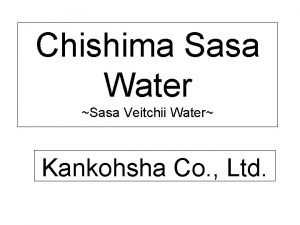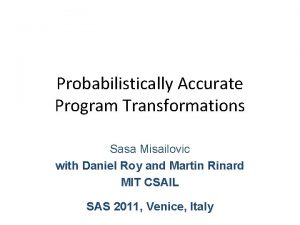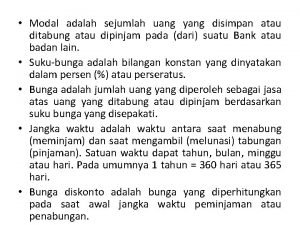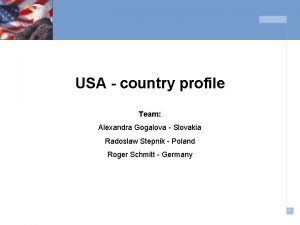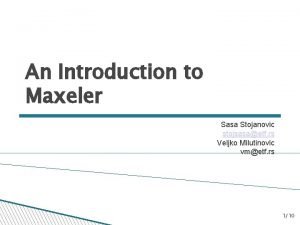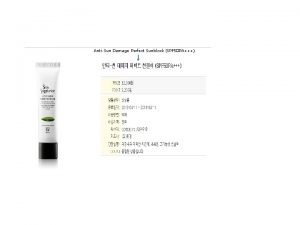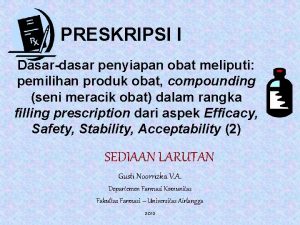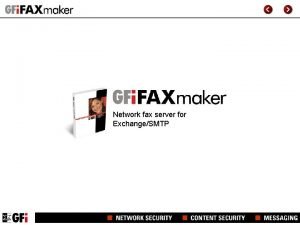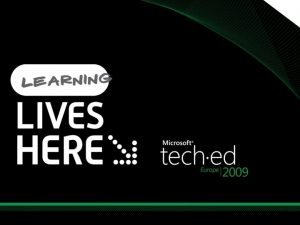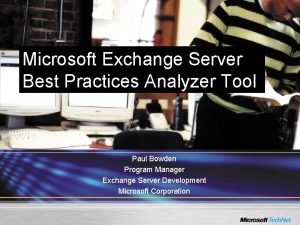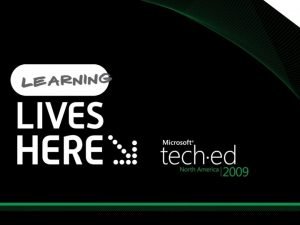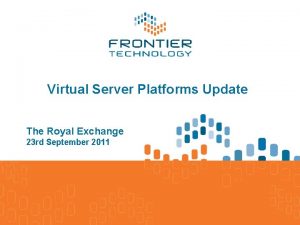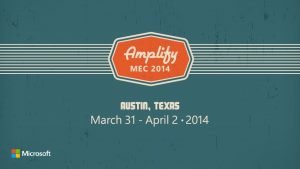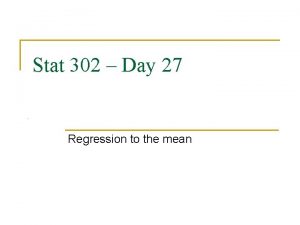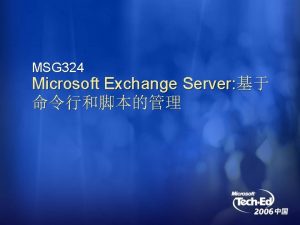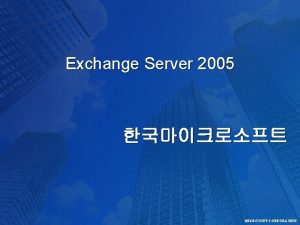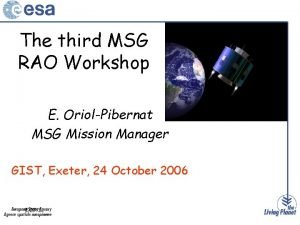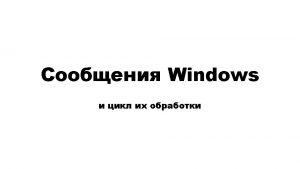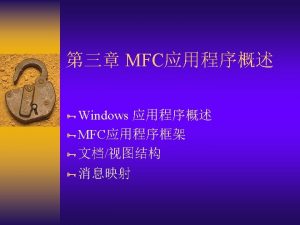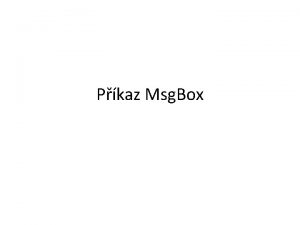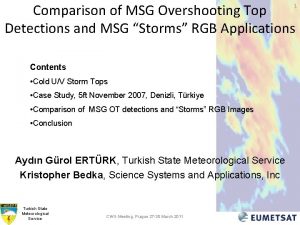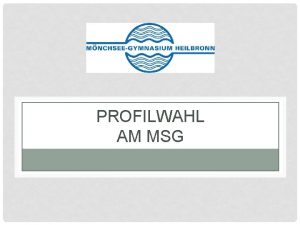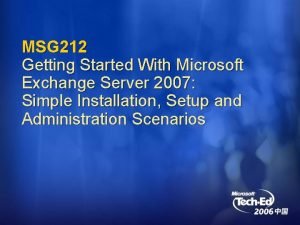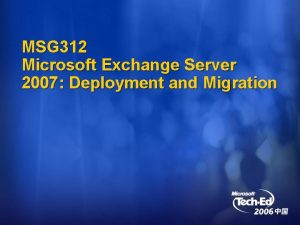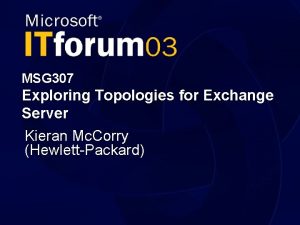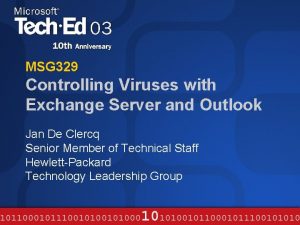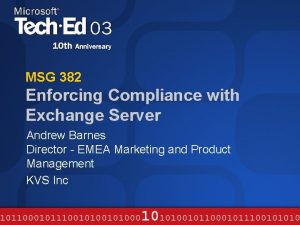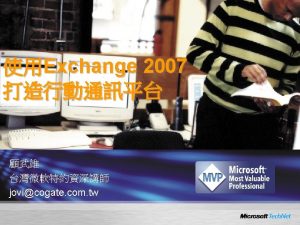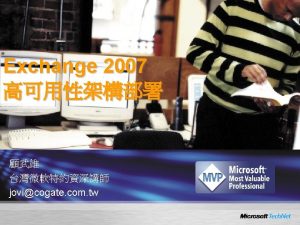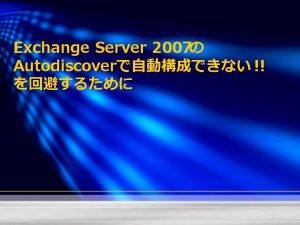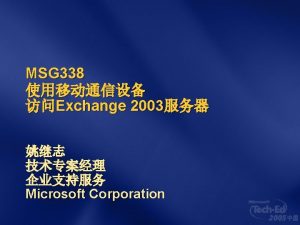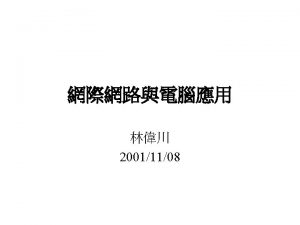MSG 302 Deploying Exchange Server Overview Sasa Juratovic








































- Slides: 40

MSG 302 Deploying Exchange Server Overview Sasa Juratovic Consultant Microsoft Ltd

Exchange Deployment Vision “Affordable Solution for Better Deployment and ROI/TCO” Improve customer satisfaction with deployment Provide prescriptive deployment guidance for customers Give customers ability to validate their setup and have confidence to continue Remove deployment blockers

The Paths To Exchange 2003 High Level Overview of Process and Tools Path 1 – Standard Deployment from Exchange 5. 5 Deploy Exchange 2003 INTO an existing Exchange 5. 5 environment Path 2 – Exchange 5. 5 as an External Migration Deploy Exchange 2003 as separate and external system from Exchange 5. 5 Path 3 – Exchange 2000 Upgrades

The Different Topologies Single Forest – Single Exchange 2003 Standard topology, and deployment case Central IT provides Exchange AND Network services Deployment through upgrade/migration of 5. 5, or from consolidations of organizations Multiple Forests – Single Exchange 2003 (Exchange Resource Forest) Good for un-trusted or distributed organizations where Central IT only provides Exchange services Deployment through upgrade, migration, or consolidations but network accounts remain in a different forest Multiple Forests – Multiple Exchange 2003 Good for highly autonomous distributed business units Central IT only provides a shared directory service

XYZ. com Forest Domain Trusts External Forest or NT 4 Domain External Accounts -w/o- E 2 k SMTP - Mail MMS – Directory PF Repl – F/B External Forest -w- E 2 k

Different Topologies Additional Information Recommended Tech-Ed Sessions MSG 307 Exploring Topologies for Exchange Server Detailed description of Exchange topologies

Path 1 – Standard Exchange 5. 5 Deployment Path

Standard Deployment Path Deploy Exchange 2003 Into Exchange 5. 5 Org Exchange 2003 is Deployed INTO existing Exchange 5. 5 Org Exchange 2003 coexists natively with Exchange 5. 5 System Configuration is inherited by Exchange 2003 servers Mailboxes are moved to new Exchange 2003 servers Who: Most Exchange 5. 5 environments Exchange 5. 5 customers with working/stable structure Mixed Mode Exchange 5. 5 and Exchange 2000 customers Benefits: Does not require/need a major re-structure Core path = Core tools Lowest administrative and client deployment costs Preserve 100% of 5. 5 organization and data

Standard Deployment Path Deploy Exchange 2003 Into Exchange 5. 5 Org The path for customers with Exchange 5. 5 servers to get to Exchange 2003 is to install an Exchange 2003 server into the site and move mailboxes. Windows 2003 GC/DC Exchange 5. 5 Exchange 2003 Windows 2000 Windows 2003 Exchange Org

Standard Deployment Path Preparing for Exchange 2003 1. 2. 3. 4. Understand Cleanup 5. 5 Environment Fulfill Basic Network Requirements Deploy and Prepare Active Directory Fulfill Basic Server Requirements Tools to help prepare for Exchange 2003 Deployment Tools ** NEW ** Active Directory Connector (ADC) ADC Tools ** NEW ** Exchange Technical Library ** NEW **

Standard Deployment Path Preparing for Exchange 2003 1. 2. 3. 4. Understand Cleanup 5. 5 Environment Fulfill Basic Network Requirements Deploy and Prepare Active Directory Fulfill Basic Server Requirements Tools to help prepare for Exchange 2003 Deployment Tools ** NEW ** Active Directory Connector (ADC) ADC Tools ** NEW ** Exchange Technical Library ** NEW **

Standard Deployment Path Deploy the Active Directory Basic Active Directory Deployment is Required Must have Windows 2000 SP 3 Domain Controllers and Global Catalogs (OR) Windows 2003 Active Directory Deploying Exchange 2003 With Accounts in NT 4 Domains or External Forests Exchange 2003 will work with accounts in a Windows NT 4 domains or external forests Exchange uses “Placeholder Accounts” in the Active Directory that reference external accounts “Placeholder Accounts” are automatically created during deployment process

Standard Deployment Path Prepare the Active Directory for Exchange Extend Active Directory for Exchange Forest Prep – To prepare forest for Exchange Domain Prep – To prepare each domain for Exchange Integrate Exchange 5. 5 Into Active Directory Deploy the Active Directory Connector Replicates 5. 5 information with Active Directory ADC Tools (New with Exchange 2003) Data Collection and Validation Resource Mailbox Wizard Connection Agreement Wizard

Standard Deployment Path Prepare the Active Directory for Exchange Extend Active Directory for Exchange Forest Prep – To prepare forest for Exchange Domain Prep – To prepare each domain for Exchange Integrate Exchange 5. 5 Into Active Directory Deploy the Active Directory Connector Replicates 5. 5 information with Active Directory ADC Tools (New with Exchange 2003) Data Collection and Validation Resource Mailbox Wizard Connection Agreement Wizard

Standard Deployment Path Deploying Exchange 2003 Install Initial Exchange 2003 Server into a 5. 5 Site Initial Exchange services are created with first server to support deployments Exchange 2003 will now inherit the same organization as 5. 5 at this point Move Content to Exchange 2003 servers Move mailboxes with Exchange Admin NEW – Schedule moves NEW – Better performance and reliability Replicate public folder content NEW – PF-migrate tool Reconfigure any connectors or special server rolls Deploy New Features Front end servers (For OWA, and OMA)

Standard Deployment Path Deploying Exchange 2003 Install Initial Exchange 2003 Server into a 5. 5 Site Initial Exchange services are created with first server to support deployments Exchange 2003 will now inherit the same organization as 5. 5 at this point Move Content to Exchange 2003 servers Move mailboxes with Exchange Admin NEW – Schedule moves NEW – Better performance and reliability Replicate public folder content NEW – PF-migrate tool Reconfigure any connectors or special server rolls Deploy New Features Front end servers (For OWA, and OMA)

Path 2 – Exchange 5. 5 as an External Migration

External Migration Path Deploy Exchange 2003 as an External Organization Exchange 2003 is Deployed as NEW and External Organization No configuration is preserved from Exchange 5. 5 Mailboxes are selectively migrated between old and new system Coexistence is optional but requires additional steps to setup May require third party tools for migration of additional data Who: Some Exchange 5. 5 Environments Multiple Exchange 5. 5 Organizations Major topology change needed Why Not? Higher cost for migration by both administration and clients Need to preserve 100% of Exchange 5. 5 Environment

External Migration Path Deploy Exchange 2003 as an External Organization An External Migration is where Exchange 2003 is installed in a NEW/External Exchange organization. Selective mailboxes are migrated to Exchange. Windows 2003 GC/DC Exchange 5. 5 Org Exchange 5. 5 Windows 2000 Exchange 2003 Org Exchange 2003 Windows 2003

External Migration Path Preparing for Exchange 2003 1. 2. 3. Understand Cleanup 5. 5 Environment Fulfill Basic Network Requirements Deploy and Prepare Active Directory Extend Active Directory for Exchange Integrate 5. 5 Directory and Active Directory 4. Fulfill Basic Server Requirements Tools to help prepare for Exchange 2003 Deployment Tools ** NEW ** Exchange Technical Library ** NEW **

External Migration Path Deploy Exchange 2003 and Setup Coexistence Deploy Exchange 2003 Org Use Deployment Tools to start Setup DO NOT join a 5. 5 organization Setup Connectors, Front-Ends, Etc. Setup Coexistence (Optional Extra Steps) Directory Coexistence Use ADC Inter-Org Mode to create contacts in an Active Directory DO NOT use ADC Tools Messaging/Calendaring Coexistence Setup SMTP Connectors between orgs Free/Busy and Public Folder Coexistence Deploy Inter-Org Public Folder Replication Tool

External Migration Path External Migration of Data Mailbox Migration Exchange 2003 Migration Wizard, Installed with Exchange General migration tool for migration of mailboxes from external systems (Exchange, Notes, Group. Wise, etc. ) Migrates mailbox content and mailbox directory information If directory co-existence is in place, reply-ability will be preserved Additional Manual Tasks for Migration Cleanup of mailboxes after migration Client tasks to reset outlook profile, fix rules and reset delegates

External Migration Path External Migration of Data Public Folder Migration Content can be replicated during coexistence Specific Public Folder Permissions need to be recreated Additional Directory Content Migration Contacts: Can be replicated during coexistence Distribution Lists: Need to be manually exported/imported into Active Directory

External Migration Path Some Third Party Tools Net. IQ’s Exchange Migrator ( http: //www. netiq. com ) Exchange 5. 5 Migrations Includes Mailbox Data, Public Folder Data, Access Control, Distribution Lists, Manager/Reports links Combined domain and mailbox migration solution Aelita Controlled Migration Suite ( http: //www. aelita. com ) Exchange 5. 5 Migration and Coexistence tools Service based migration (For off-hour migrations) Mailbox Data, Public Folder Data, Directory Migration Combined domain and mailbox solution Wingra ( http: //www. wingra. com ) Consulting and Migration tools for Exchange, Notes and Group. Wise migrations Group. Wise tools support Group. Wise 6 Exchange tools migrates mailbox, Access Control, Distribution Lists, and Public Folders Compusven ( http: //www. compusven. com ) Migration tools for Exchange, Notes and Group. Wise migrations Group. Wise tools supports Group. Wise 6 Email Shuttle can be scheduled for automatic migrations Discus Data Solutions ( http: //www. discusdata. com) Wizard based migration of Mailbox Data, Directory, Access Control, Distribution Lists,

Path 3 – Upgrade from Exchange 2000

Exchange 2000 Upgrades Deploy Exchange 2003 after an Exchange 2000 deployment has started Exchange 2003 is deployed into an organization where Exchange 2000 has already exists Exchange 2003, Exchange 2000 and Exchange 5. 5 can coexist in the same organization Configuration will be shared same as a standard deployment Exchange 2000 servers can be directly upgraded to Exchange 2003 Mailboxes on 5. 5 can be moved to Exchange 2003, same as standard deployment May consider consolidation during deployment Who: All Exchange 2000 Environments Mixed Exchange 2000 and 5. 5 Organizations Pure Exchange 2000 organizations Benefits Start taking advantage of Exchange 2003 features OWA, OMA, Consolidation, Admin Features, etc.

Exchange 2000 Upgrades Deploy Exchange 2003 an Exchange 2000 org Deploy Exchange 2003 into an organization where Exchange 2000 is installed OR upgrade an Exchange 2000 server Windows 2003 GC/DC Exchange 5. 5 Windows 2000 Exchange 2003 Windows 2003 Exchange Org Exchange 2000 Windows 2000

Exchange 2000 Upgrades Deploy Exchange 2003 an Exchange 2000 org Deploy Exchange 2003 into an organization where Exchange 2000 is installed OR upgrade an Exchange 2000 server Windows 2003 GC/DC Exchange 5. 5 Windows 2000 Exchange 2003 Windows 2003 Exchange Org Exchange 2003 Windows 2000

Compatibility Matrix Interoperability with Windows Server Exchange Server fully supports Windows Server 2003 AD environments. Customers can use Exchange 5. 5 SP 3, Exchange 2000 SP 2/SP 3, and Exchange 2003 with Windows 2003 GCs and DCs Exchange 2003 Server is the only version of Exchange supported to be run on Windows Server 2003 Exchange can be installed and run on Supported Active Directory Environments Exchange Version Windows Server 2000 Windows Server 2003 Exchange 5. 5 SP 3 Yes No Yes Exchange 2000 SP 2 Yes No Yes Exchange 2000 SP 3 Yes No Yes Exchange 2003 Yes (W 2 K SP 3) Yes

Exchange And Windows 2003 Server All of these servers can coexist in the same topology. Windows 2000 SP 3 GC/DC Exchange 5. 5 NT 4 Exchange 5. 5 Windows 2000 Windows 2003 GC/DC Exchange 2003 Windows 2003 Exchange 2000 Exchange 2003 Windows 2000 SP 3

Exchange 2000 Upgrades Preparing for Exchange 2003 Prepare Active Directory for Upgrade all ADCs to Exchange 2003 Upgrade Active Directory to have at least one Windows 2000 SP 3 DC, or Windows 2003 DC in each site Prepare Forest with Forest Prep Extends Schema Prepare each domain with Domain Prep Updates domain permissions for Exchange 2003 Prepare servers for Upgrade New software requirements Windows 2000 SP 3 or Windows 2003. Net Framework and ASP. NET

Exchange 2000 Upgrades Preparing for Exchange 2003 Consider Legacy Components Features that are no part of default Exchange 2003 Instant Messaging and Chat Service Microsoft RTC Key Management Service (KMS) Windows Certs Consider New Security Features (Secure by Default) Services not installed by default, and permissions on Exchange servers Exchange Server 2003 Security Enhancements

Exchange 2000 Upgrades Deploying Exchange 2003 Installing New Servers Run Setup and join existing organization Can be new front end or back-end servers Upgrade Front End Servers Use Deployment Tools to Upgrade Must upgrade front-end servers first AND must upgrade back-end servers before new OWA and OMA features are exposed Upgrading Exchange 2000 and back-end servers Use Deployment Tools to upgrade Consolidating on Exchange 2003 Move mailboxes using NEW Exchange 2003 admin Move mailbox within same Admin group if 5. 5 servers exist or between admin groups if in native mode

The Paths To Exchange 2003 High Level Overview of Process and Tools Path 1 – Standard Deployment from Exchange 5. 5 Deploy Exchange 2003 INTO an existing Exchange 5. 5 environment Path 2 – Exchange 5. 5 as an External Migration Deploy Exchange 2003 as separate and external system from Exchange 5. 5 Path 3 – Exchange 2000 Upgrades

Questions… sasaj@microsoft. com

Ask The Experts Get Your Questions Answered I will be available in Ask the Experts area tomorrow at 11: 15 for 2 hours

Community Resources http: //www. microsoft. com/communities/default. mspx Most Valuable Professional (MVP) http: //www. mvp. support. microsoft. com/ Newsgroups Converse online with Microsoft Newsgroups, including Worldwide http: //www. microsoft. com/communities/newsgroups/default. mspx User Groups Meet and learn with your peers http: //www. microsoft. com/communities/usergroups/default. mspx

Suggested Reading And Resources The tools you need to put technology to work! TITLE Microsoft® Exchange Server 2003 Administrator's Companion: 07356 -1979 -4 Active Directory® for Microsoft® Windows® Server 2003 Technical Reference: 0 -73561577 -2 Available 9/24/03 Today Microsoft Press books are 20% off at the Tech. Ed Bookstore Also buy any TWO Microsoft Press books and get a FREE T-Shirt

evaluations

© 2003 Microsoft Corporation. All rights reserved. This presentation is for informational purposes only. MICROSOFT MAKES NO WARRANTIES, EXPRESS OR IMPLIED, IN THIS SUMMARY.
 Deploying deep learning models with docker and kubernetes
Deploying deep learning models with docker and kubernetes Dutchman fire hose
Dutchman fire hose Exchange online protection overview
Exchange online protection overview Saša divjak
Saša divjak Sasa kurilensis water
Sasa kurilensis water Saša kadivec
Saša kadivec Sasa misailovic
Sasa misailovic Saša ogrizek
Saša ogrizek Fajar menabung sejumlah uang di bank
Fajar menabung sejumlah uang di bank Alexandra gogalova
Alexandra gogalova Sasa atanaskovic
Sasa atanaskovic Sasa stojanovic etf
Sasa stojanovic etf Katarina susman
Katarina susman Sasa sunscreen
Sasa sunscreen Contoh sediaan netralisasi
Contoh sediaan netralisasi Sasa shinichi
Sasa shinichi Dupljari gradja
Dupljari gradja Alexandra gogalova
Alexandra gogalova Kresliaci program art
Kresliaci program art Dr marija skok
Dr marija skok Frase completa
Frase completa Sasa toner
Sasa toner Scifozoa
Scifozoa Saša ilijić
Saša ilijić Sasa misailovic
Sasa misailovic Sasa malkov
Sasa malkov Helioporacea
Helioporacea Gas exchange key events in gas exchange
Gas exchange key events in gas exchange Determination of exchange rate
Determination of exchange rate Voluntary exchange activity the pearl exchange
Voluntary exchange activity the pearl exchange Serveur fax
Serveur fax Microsoft forefront security for exchange server
Microsoft forefront security for exchange server Microsoft forefront protection 2010 for exchange server
Microsoft forefront protection 2010 for exchange server Cb exchange server sync
Cb exchange server sync Exchange best practices analyzer
Exchange best practices analyzer Mcse exchange server
Mcse exchange server Exchange control panel 2010
Exchange control panel 2010 Exchange virtual server
Exchange virtual server Exchange onpremises
Exchange onpremises Exchange server demo
Exchange server demo Stat 302
Stat 302




